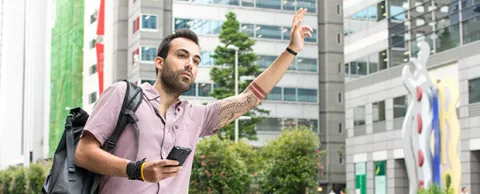
There’s no question that the app-based, private vehicle taxi services Lyft and Uber have dramatically changed the way people get around cities. It’s been hard to quantify their impact, but San Francisco has made an incredible effort.
San Francisco and researchers at Northeastern University found a novel way to track Lyft and Uber vehicles by using the data they provide to people who use their apps. (The services vehemently resist calls to share their data.) The big headline is that there are a lot of Lyfts and Ubers. In fact, in some parts of San Francisco at certain times of day, they count for one in four vehicles on the road. But the findings also go much farther than that.
You can download the report and some raw data. The county has also created an interactive map to bring the data to life. But we’ve summarized some of the most interesting findings below, which you may want to use as a guide as you factor how these services fit into your city’s mobility framework. — Kevin Ebi
1. Lyft and Uber dominate the for-hire transportation business
Anymore, if you’re looking for an on-demand ride, odds are it’s going to be with a Lyft or Uber driver. During peak periods, there can be as many as 6,500 vehicles managed by the ride-hailing services on San Francisco’s streets.
By comparison, the city has a total of 1,800 licensed taxis. In other words, during the busiest times, 80% of the for-hire vehicles are controlled by the two apps.
2. Drivers are difficult to regulate and don’t live where they work
Drivers who work for Lyft and Uber are supposed to register with San Francisco if they drive in the city. The city sent letters to the 45,000 drivers it identified alerting them to that requirement. Just 21,000 — less than half — complied.
One issue may be that relatively few of the ride-hailing service drivers who work San Francisco’s streets actually live there. Just 29% are based in San Francisco. While most of the others are from neighboring cities, the report found that 10% of the drivers don’t even live in the Bay Area. The apps’ drivers may commute a fair distance to work in the city.
3. Those ride-hailing services rack up a lot of miles
Ride-hailing services make more than 170,000 trips each weekday within San Francisco. Each day, those trips amount to about 570,000 miles. And the impact is likely even bigger. The study looked only at trips that were completely contained within San Francisco. Trips that start or end at the airport, for example — there were more than 600,000 of those in April alone — weren’t counted.
It follows that the drivers want to be where the most people — and potential customers — are. In the busiest parts of the city, the study found at peak times, 25% of the vehicles on the road were driven by Uber or Lyft drivers.
It’s not clear if that adds to the congestion or just replaces personal vehicles that would have made those trips had ride-hailing services not been available.
4. App-based services are more efficient than taxis
For all the miles that the Uber and Lyft drivers put in each day, they are fairly efficient. On a typical weekday, just 21% their miles occur without a paying customer in the car. With taxis, however, nearly 44% of their miles are out-of-service miles. And on weekends, that rate climbs for taxis while it falls for the ride-hailing services.
Considered another way, for every mile a taxi takes a customer, it drives almost an additional mile to get into position for the next customer. Lyft and Uber, meanwhile, usually get three or four fare miles for every wasted mile.
The study says the app-based services have two edges. First, there have so many more vehicles on the road that odds are one of them is close to someone who wants a ride. Second, their platform and all the data they collect may help them better manage where they encourage drivers to go.
5. Ride-hailing services provide wider service, but aren’t equitable
With so many vehicles available, one would assume that Lyft and Uber are able to provide more people with more service. The report found that in the city’s western neighborhoods, the level of service improved with the ride-hailing services arrived. But that’s not true for everyone.
In particular, the southern and southeastern parts of the city are underserved. The report finds relatively few ride-hailing vehicles make it to those areas considering the number of people who live and work there. What’s not clear is if that’s a factor of drivers not wanting to go there, or people there not wanting or being able to use the service.



